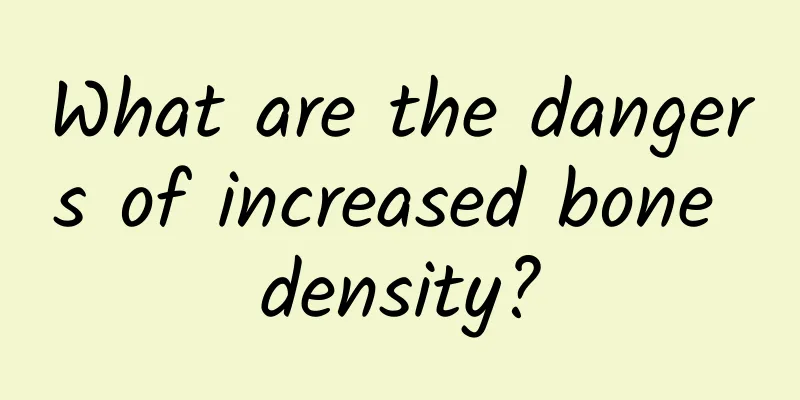What are the dangers of increased bone density?

|
As for the question of what bone density is, I believe everyone knows that the bone density value for each age group is different. Take the childhood stage as an example. If it is lower than the standard value, it means there is still a possibility of growth; if it is higher than the standard value, it means that the chance of growth is getting smaller and smaller. Therefore, it is obvious that high bone density is not a good thing. So what are the dangers of increased bone density? 1. Normal value of bone density: Normal: Bone density is within 1 standard deviation (+1 to -1SD) of the mean value for young people. Low bone density: Bone density is 1 to 2.5 standard deviations (-1 to -2.5SD) below the average value of young people. Osteoporosis: Bone density is less than 2.5 standard deviations below the mean for young adults (less than -2.5SD). Severe osteoporosis: Bone density is 2.5 standard deviations below the mean for young people, accompanied by one or more osteoporotic fractures. What is high bone density? Generally, around the age of 35, a person's bone mass reaches its highest value in life, and the calcium content at this time is the person's peak bone mass. It is mainly determined by three factors: genetic factors; calcium supplement factors; physical exercise conditions. Therefore, osteoporosis is not exclusive to middle-aged and elderly people. This silent epidemic is quietly affecting the health of young women in their twenties and thirties. Therefore, modern women should change their mindset, change their lifestyles, and arrange their own and their family's lives reasonably according to actual conditions, so that osteoporosis does not "come to them" too early. There are many reasons for high bone density, the most common ones are: 1. Bone sclerosis: Bone sclerosis is the result of increased bone mass. It is a compensatory response of the body and can be seen in many diseases. Localized bone sclerosis and hyperplasia are seen in chronic inflammation and malignant bone tumors. Generalized bone sclerosis is seen in osteopetrosis, renal osteosclerosis and fluorosis. X-rays show increased bone density, thickened cortex, thickened bone shaft, narrowed or disappeared medullary cavity, and disappearance of trabeculae, resulting in a dense image. Although the tumor bone in osteosarcoma shows bone hyperplasia and sclerosis, it is not a compensatory response of the body but a part of the tumor tissue. 2. Bone compression: Bone compression increases the bone mass per unit volume, thereby increasing bone density. Bone compression is most common in vertebral compression fractures, but it can also be seen in bone avascular necrosis, in which the increased density often results in uneven images. 3. Calcification in bone: pathological tissue in bone such as tumor and inflammatory tissue. Both bone marrow lesions and ischemic diseases can cause bone calcification, which appears as a high-density, structureless, granular image. 4. Abnormal mineral deposition in bones: Lead, phosphorus, bismuth, etc. enter the human body and are mostly deposited in bones. During the growth period, they are mainly deposited in the faster growing epiphyseal part, which appears as horizontal bands with increased density. It is not easy to show to adults. Bone density is a primary indicator of bone strength. After the human body's bone density reaches its peak, it will inevitably lose bone mass with age, so that bone density will decrease and bone strength will deteriorate. However, if the peak bone density is higher during adolescence, it can counteract the bone loss caused by aging, which is of great significance for preventing osteoporosis in adulthood. Therefore, maintaining as much bone mass as possible before the end of puberty is crucial to achieving peak bone density. It can be seen from this that high bone density may be a sign of certain diseases, which should be taken seriously and diagnosed as soon as possible. |
<<: What to do if you have a sore throat due to a cold
>>: What to do if children have low bone density
Recommend
Are Chinese medicine and food compatible or incompatible?
Nowadays, more and more people like to see Chines...
What are the general functions and effects of soaking Matsutake in wine?
Matsutake is a rare and purely natural species. E...
How to treat anxiety and depression more effectively?
When it comes to the topic of anxiety disorder, m...
How long does it take to treat facial paralysis?
Facial paralysis is a relatively common disease. ...
What are the symptoms of fatty liver?
As people's living standards have improved, t...
Can dandelion cure skin diseases?
Dandelion is a common wild vegetable in our lives...
What are the benefits of Korean ginseng wine?
Generally, Chinese medicine pays attention to hea...
How can I get enough sleep?
Sleep is of vital importance to each of us. Witho...
Dosage of Broken Wall Ganoderma Lucidum Spore Powder
The efficacy and function of the broken wall cook...
Blood in stool
In everyone's cognition, only hemorrhoids can...
What is the reason for the protruding tendons on the forehead?
The blue veins on the forehead are not unfamiliar...
Acupuncture Zusanli for soreness and swelling in the hind legs
Zusanli is an important acupuncture point in the ...
How should consumptive cough be treated?
Coughing is a physiological reaction of the human...
What are the symptoms of liver depression and spleen deficiency? How to regulate liver depression and spleen deficiency?
Liver depression and spleen deficiency refer to a...
Is a hard bump on my finger a plantar wart?
Some people who work at high intensity for a long...









